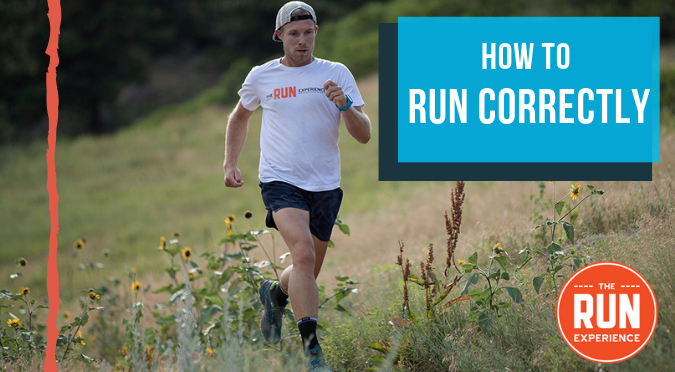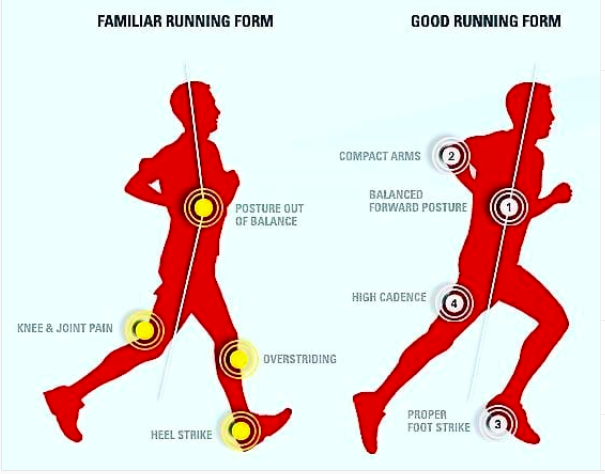How to Run Properly: Running Form Tips & Techniques
Learn how to run properly with these running form tips, drills, and techniques to run faster, perform better, and avoid injury.

While nearly anyone can pick up the sport of running with a little practice, learning how to run correctly with consistent good form can take a little time. And, bad running form can lead to a myriad of issues, pain, and injuries that can keep you off your feet.
Maybe you get back from a run with scuffed calves or you wear out the outside of your shoe sole before the rest. Or, you run on your toes and put too much stress on your calves. These are signs your running form can improve–and we’re here to help!
How to Run Properly
Running, one of the most natural forms of exercise, requires a bit more than just putting one foot in front of the other. Good running form is essential not only for performance enhancement but also for injury prevention.
Whether you're a seasoned marathoner or a casual jogger, understanding and implementing proper running techniques can make a significant difference.
Let's explore the key components of proper running form.
- Posture: Maintain an upright posture while running. Slouching or leaning too far forward can lead to back pain and inefficiency in breathing. Keep your head up and your gaze forward. This alignment helps in maintaining an overall straight posture, ensuring your neck and back are not strained.
- Arms Mechanics: Your arms should swing naturally with a bend at the elbows. This movement helps in balancing your body and conserving energy. Avoid clenching your fists. Keep your hands relaxed, as tension in your hands can travel up to your arms and shoulders, leading to fatigue.
- Footwork: Aim for a mid-foot strike, where your foot lands below your hip—the center of gravity. This technique reduces the impact on your knees and joints.
- Stride Length: Avoid overstriding. A common mistake is landing with the foot too far ahead of the body, which can cause braking with each step and increase the risk of injury.
- Breathing: Coordinate your breathing with your steps for better oxygen flow. Try inhaling for three steps and exhaling for two, adjusting as needed.
- Core: Keep your core muscles lightly engaged. A strong core stabilizes your torso, reducing the swaying motion and improving efficiency.
- Pace: Find a comfortable, sustainable pace for longer runs. Avoid starting too fast, which can lead to early fatigue.
What Is the Best Way to Run?
When it comes to running, there's no universal "best" way that fits everyone. Running styles vary widely, and what works exceptionally well for one person might not be ideal for another. This diversity is evident even among elite athletes—some of the world's best marathoners exhibit a heel strike, while others are forefoot strikers.
Whether it’s a heel strike, mid-foot strike, or forefoot strike, each has been seen in successful runners. The key is efficiency and comfort in your stride that aligns with your body’s mechanics. While general guidelines suggest an upright posture and relaxed arm swing, variations exist. Some runners naturally lean forward more, while others may have a slightly different arm carriage.
Pay attention to what feels most natural and efficient for your body. If a certain style or technique causes discomfort or reduces your efficiency, it may not be suitable for you. Be mindful of any pain or discomfort. While experimenting with running form is normal, consistently running in a way that causes pain can lead to injuries.
Feel free to experiment with different styles and techniques. Over time, you'll find a running form that feels the most natural and efficient for you. Consider seeking advice from a running coach or a sports physiotherapist, especially if you're new to running or making significant changes to your running style.
TLDR: While it's beneficial to be aware of best practices in running form, remember that individual variation is vast and completely normal. The best way to run is the way that feels most natural and efficient for you, aligns with your running goals, and keeps you injury-free. Embrace your unique running style and enjoy the journey of finding what works best for you.
6 Running Form Tips
Before we dive into a specific drill video, here are our top running form tips for cultivating excellent running form:
1. Keep Your Shoulders Down
Don’t hunch your shoulders. Focus on keeping them down–and away from your ears! Pull your shoulders back, like you are imagining squeezing a pen between your shoulder blades–this also helps maintain endurance.
2. Get Your Head Straight
Set your gaze straight ahead of you, looking around 20 to 30 meters out. Don’t look at your feet unless you’re doing a short drill (more about that later in this post).
Looking down can cause tension to build up in your shoulders and neck–and we want a relaxed neck and jaw for proper running form. Furthermore, don’t jut your head forward–your ears should be in line with your shoulders.
3. Relax Those Hands
This comes more naturally for some people rather than others. Personally, I have a tendency to run with my hands clamped up in a fist, so I have to be intentional about relaxing them—it can create tension in your shoulders and back.
4. Go for a Mid-Foot Strike
While every runner has a natural strike, trying to nurture a mid-foot strike is the best way to land. A heel strike and forefoot strike are common–but focus on landing on the middle of your foot regularly.
5. Control Your Knee Lift
If you lift your knees too high during your run, your running will be bouncy and your body will absorb more impact with each stride. Run with a slight bend in your knee to limit your the impact of training on hard surfaces.
There’s a place for high knee action in running drills, but during your run, keep it low and lift your knees forward, not upwards.
6. Lean Forward Slightly
Don’t ever lean back or stay completely upright while running. Lean forward slightly, hinged at the hips.

-Photo Credit: holisticmarathoner
Fortunately, there’s no shortage of simple running form drills that can teach you how to run correctly—and help you stay injury-free so you can enjoy every run.
What Does Bad Running Form Look Like?
While there's no one-size-fits-all approach to running, there are a few signs you can look for to see if you've adopted bad running form habits. Remember, if you're not experiencing pain or a lack of progression, this doesn't necessarily need to be something to worry about.
However, if you're getting frequent injuries or can't manage to build up your aerobic base, you might need to improve your running form. Here are some general signs to watch for:
1. Overstriding:
- Sign: Landing with your foot well ahead of your center of gravity, often leading to a pronounced heel strike.
- Impact: Overstriding can reduce efficiency and increase the risk of injuries like shin splints and knee pain due to the excessive braking force with each step.
2. Excessive Bouncing:
- Sign: A noticeable vertical movement with each stride, which wastes energy.
- Impact: This 'bouncy' running can lead to quicker fatigue as more energy is spent moving up and down rather than propelling forward.
3. Poor Posture:
- Sign: Slouching or leaning too far forward or backward while running.
- Impact: Bad posture can lead to back and neck pain and may hinder proper lung function, impacting your breathing.
4. Tense Upper Body:
- Sign: Clenched fists, tight shoulders, or a rigid upper body.
- Impact: Tension in the upper body can lead to unnecessary fatigue and discomfort, affecting overall running efficiency.
5. Inefficient Arm Swing:
- Sign: Arms crossing over the body’s midline or an overly aggressive arm swing.
- Impact: This can cause rotational movement in the torso, reducing running efficiency and potentially leading to imbalances.
6. Asymmetrical Movement:
- Sign: Uneven stride or arm swing, often noticeable when one side appears different or less coordinated than the other.
- Impact: Asymmetry can indicate muscle imbalances or weaknesses, potentially leading to injuries.
7. Ignoring Pain or Discomfort:
- Sign: Continuing to run through pain or not adjusting form when something feels off.
- Impact: Running through pain can exacerbate injuries and lead to longer-term issues.
5-Minute Running Form Fix
Today, let’s follow along with Coach Nate to explore a five-minute running form fix you can incorporate into your workouts today.
When it comes to learning how to run correctly, think of all of the elements like an orchestra. We need to combine running nice and tall, proper hip rotation and extension, strong core strength, and stability.
Often, at the beginning of a run, we have great form. But, as we log the miles and our bodies begin to fatigue, our form can suffer if we aren’t intentional about correcting it.
This five-minute form fix teaches us how to dial in our rotation and increase stability to keep the body from overcompensating in certain areas when we fatigue starts to set in.
Bonus: Are you looking for running drills to help you run faster? Read this article and watch the video included to discover seven drills that can help get you to your next PR faster.
Focus on Your Arms
Naturally, running has an innate focus on the legs since they are doing so much work. However, it’s just as important to have a proper arm swing because it helps balance your form–keeping your shoulders and hips neutral and stable with every stride.

When you get tired during a run, your shoulders tense up and your arm swing starts to go away. Then your upper body begins to overcompensate and twist from side to side.
Once you’re overtwisting, things can go downhill fast. You’ll lose connection with your pelvis, your hips will drop with each step, and you’ll notice you scuff your calves every few strides. I’ve definitely personally noticed how dirty my calves can get at the end of a long run!
The Stable Arm Drill
So, how do we prevent losing proper arm swing when we get tired? Enter the stable arm drill. This exercise focuses in on stability and rotation to protect the hips by taking the arm swing away. Here’s how:
- Jog lightly in place. Notice how your arms naturally assume a contralateral movement–they move the opposite direction of your legs.
- This will feel silly, but it helps. Run with your arms out straight (imagine Frankenstein running) for 20 meters or about 15-20 seconds.
- You’ll notice that your upper body starts to twist because your arms aren’t moving. Now, your goal is to minimize as much twisting as possible.
- Stabilize your core and make sure you’re running tall. Keep it tight!
- Repeat this exercise three times.
- We’re not through with this one yet! Do three more rounds–but this time, put your hands together in front of you. It makes it even more challenging to keep your upper body from twisting, but it’s great practice.
When you go back to letting your arms swing, you’ll immediately notice the purpose it serves. Practice this drill a few times per week to remind yourself how to run correctly when fatigue sets in.
Focus From the Bottom Up
Now that you’ve gained an appreciation for what a good arm swing does for your from, let’s focus from the bottom up to avoid what we call, “tightroping”–when you over-rotate and your legs start to resemble someone walking a narrow tightrope. I’ve even tripped myself a few times at the end of a long run!
All you’ll need is a line to follow on the side of a road–just don’t use a double yellow line!
The White Line Drill
- Choose a course that has a line on the side to use as a marker for your feet.
- When you stand naturally, your feet are usually about hip-width apart. When you’re running, your feet should land with a bit of space between them.
- Use the line to make sure you’re feet are straddling the line with each stride. This helps prevent over-rotation–which causes that “tightroping” stride.
- Don’t go too wide–you know the stride is too wide if you feel like you’ve just gotten off a horse!
- Straddle the line for 30-60 seconds. Repeat for three to five rounds.
Incorporate these two simple drills into your running schedule every week to encourage proper form and mobility. Looking for running form tips for beginner runners? Check out this article for the best advice.
Checklist for Proper Running Form
We've covered a lot, and it's going to be hard to remember without frequently checking in, measuring progress, and re-reading this post. To help, we've made a quick handy-dandy proper running form checklist to reference. Refer to it before, during, and after your runs to guarantee you’re following the key points covered in the article:
Posture:
- Maintain an upright posture.
- Keep your head up and gaze forward.
- Avoid slouching or leaning too far forward.
Arm Mechanics:
- Swing your arms naturally with a bend at the elbows.
- Keep your hands relaxed, avoiding clenched fists.
Footwork:
- Aim for a mid-foot strike.
- Ensure your foot lands below your hip.
Stride Length:
- Avoid overstriding.
- Keep your strides short and quick.
Breathing:
- Coordinate your breathing with your steps.
- Try a 3:2 inhale-exhale pattern, adjusting as needed.
Core:
- Engage your core muscles lightly.
- Stabilize your torso to reduce swaying.
Pace:
- Find a comfortable, sustainable pace.
- Avoid starting too fast to prevent early fatigue.
Common Mistakes to Avoid:
- Starting too fast
- Ignoring recovery runs
- Inconsistent pacing
- Neglecting to adjust for conditions
- Relying solely on technology
- Skipping warm-ups and cool-downs
Running Form Drills:
- Stable Arm Drill:
- Run with arms out straight for 20 meters.
- Minimize upper body twisting.
- White Line Drill:
- Straddle a line on the road with each stride.
- Maintain proper foot placement to avoid over-rotation.
Signs of Bad Running Form:
- Overstriding
- Excessive bouncing
- Poor posture
- Tense upper body
- Inefficient arm swing
- Asymmetrical movement
- Ignoring pain or discomfort
Learn the Best Running Techniques
Learning how to run correctly and get stronger on a regular basis is a process, and we’re here to help in that journey. That’s why we’ve released a new mobile app! What are you waiting for? Download our app today to discover workouts and training advice that will bring you to the next level.
